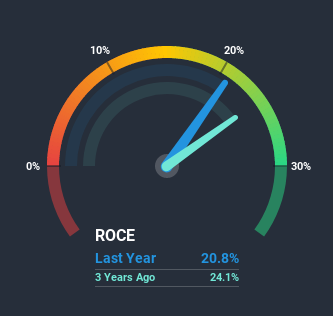- United States
- /
- Chemicals
- /
- NYSE:NEU
Returns On Capital At NewMarket (NYSE:NEU) Paint A Concerning Picture

If we want to find a stock that could multiply over the long term, what are the underlying trends we should look for? Firstly, we'll want to see a proven return on capital employed (ROCE) that is increasing, and secondly, an expanding base of capital employed. Put simply, these types of businesses are compounding machines, meaning they are continually reinvesting their earnings at ever-higher rates of return. So while NewMarket (NYSE:NEU) has a high ROCE right now, lets see what we can decipher from how returns are changing.
What is Return On Capital Employed (ROCE)?
For those that aren't sure what ROCE is, it measures the amount of pre-tax profits a company can generate from the capital employed in its business. To calculate this metric for NewMarket, this is the formula:
Return on Capital Employed = Earnings Before Interest and Tax (EBIT) ÷ (Total Assets - Current Liabilities)
0.21 = US$337m ÷ (US$1.9b - US$312m) (Based on the trailing twelve months to December 2020).
So, NewMarket has an ROCE of 21%. That's a fantastic return and not only that, it outpaces the average of 7.1% earned by companies in a similar industry.
Check out our latest analysis for NewMarket

Historical performance is a great place to start when researching a stock so above you can see the gauge for NewMarket's ROCE against it's prior returns. If you want to delve into the historical earnings, revenue and cash flow of NewMarket, check out these free graphs here.
What Can We Tell From NewMarket's ROCE Trend?
When we looked at the ROCE trend at NewMarket, we didn't gain much confidence. Historically returns on capital were even higher at 35%, but they have dropped over the last five years. On the other hand, the company has been employing more capital without a corresponding improvement in sales in the last year, which could suggest these investments are longer term plays. It's worth keeping an eye on the company's earnings from here on to see if these investments do end up contributing to the bottom line.
What We Can Learn From NewMarket's ROCE
To conclude, we've found that NewMarket is reinvesting in the business, but returns have been falling. Unsurprisingly, the stock has only gained 4.4% over the last five years, which potentially indicates that investors are accounting for this going forward. As a result, if you're hunting for a multi-bagger, we think you'd have more luck elsewhere.
Like most companies, NewMarket does come with some risks, and we've found 1 warning sign that you should be aware of.
If you want to search for more stocks that have been earning high returns, check out this free list of stocks with solid balance sheets that are also earning high returns on equity.
If you decide to trade NewMarket, use the lowest-cost* platform that is rated #1 Overall by Barron’s, Interactive Brokers. Trade stocks, options, futures, forex, bonds and funds on 135 markets, all from a single integrated account. Promoted
Valuation is complex, but we're here to simplify it.
Discover if NewMarket might be undervalued or overvalued with our detailed analysis, featuring fair value estimates, potential risks, dividends, insider trades, and its financial condition.
Access Free AnalysisThis article by Simply Wall St is general in nature. It does not constitute a recommendation to buy or sell any stock, and does not take account of your objectives, or your financial situation. We aim to bring you long-term focused analysis driven by fundamental data. Note that our analysis may not factor in the latest price-sensitive company announcements or qualitative material. Simply Wall St has no position in any stocks mentioned.
*Interactive Brokers Rated Lowest Cost Broker by StockBrokers.com Annual Online Review 2020
Have feedback on this article? Concerned about the content? Get in touch with us directly. Alternatively, email editorial-team (at) simplywallst.com.
About NYSE:NEU
NewMarket
Through its subsidiaries, primarily engages in the manufacture and sale of petroleum additives.
Outstanding track record established dividend payer.
Similar Companies
Market Insights
Community Narratives



